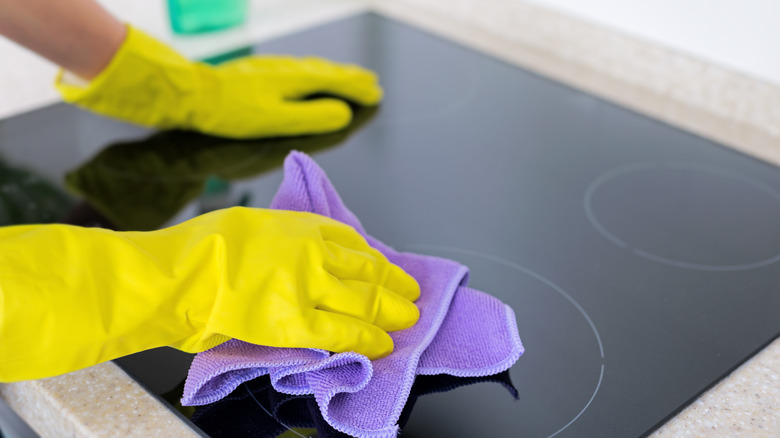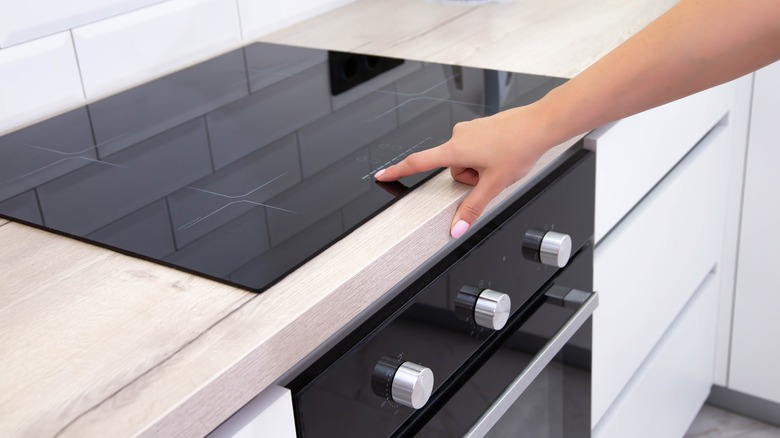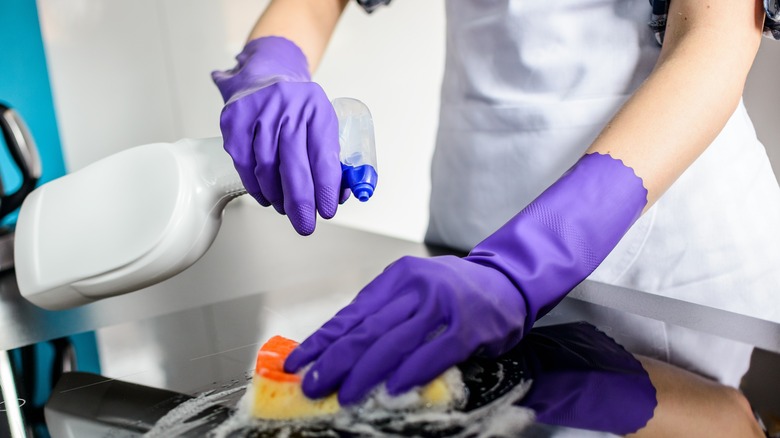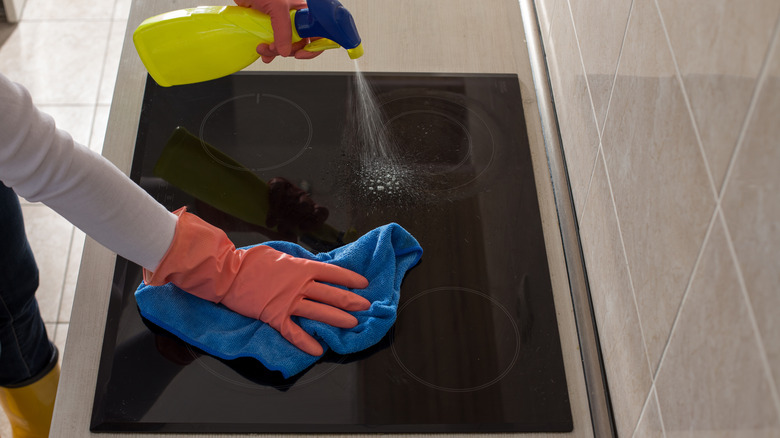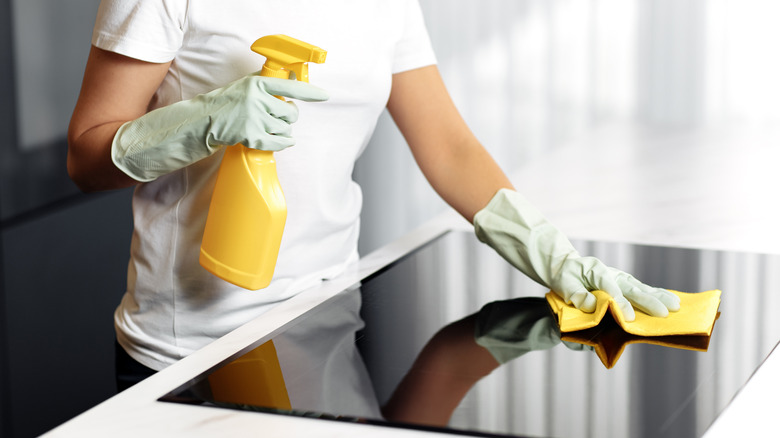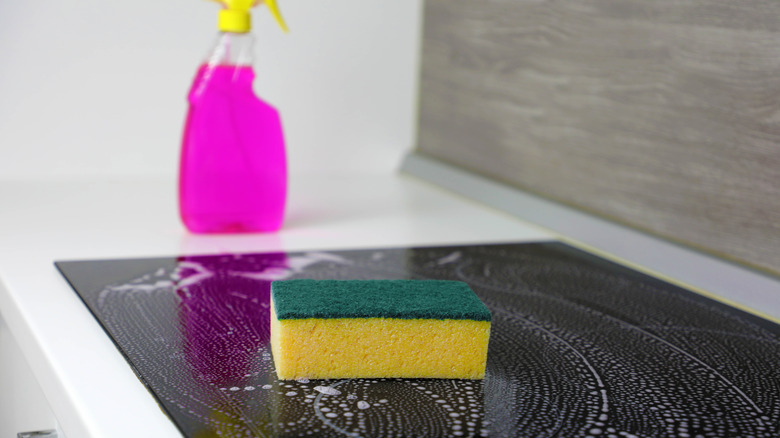How To Clean An Induction Stove Top
Cooking is fun until it comes to the cleanup afterward. If you love cooking then you will know how stove tops can get messy when you are on a cooking spree. While induction cooktops enhance your kitchen décor and are more efficient, the glass surface can get very messy compared to electric or gas cooktops. Cleaning them as soon as the mess occurs not only makes your work easier but also helps avoid residue build-up that might damage the cooktop. Therefore, it is important to know how to make your stoves last longer by using the right cleaning materials and methods.
Failure to handle induction stove tops with care can lead to surface scratches or ugly stains. Moreover, Cookery Space explains that induction stoves heat food via a magnetic coil, which can stop functioning correctly if left without cleaning. If you are wondering how you can keep your glass stove top looking spotlessly clean, here are some useful tips to you get started.
Carefully observe available instructions
The easiest way to start off the task is to go through the manufacturer's cleaning instructions. Hereafter, the process is not complicated and will only take a few minutes of your time. You don't have to prepare a whole meal for you to shine your glass stove top back to its glory. Most times even a simple activity like steaming can leave your cooktop grimy. You have to wipe off the steam using microfiber clothes, cleaning wipes, or paper towels.
Tree House recommends that you prevent damage and scratches by using soft clothes designed for glass cleaning. Clean the stains when they are still wet using a soft sponge. Allow the area to completely cool off before you clean to achieve a streak-free finish. The product description will also give you an extensive guide on the right cleaning products to use. One secret for a long-lasting induction cooktop is to avoid the use of glass cleaners. Simply Better Living warns that glass cleaners contain ammonium hydroxide, which could damage your induction stovetop.
Clean cautiously bit by bit
Once you have identified the right cleaning materials, the next step is handling the mess. According to Whirpool, you can clean your cooktop in four easy steps. First, remove any burnt food remnants using a special scrapper designed specifically for induction stoves. Consider using a glass top scrapper on stubborn residues that won't come off. However, only do this after letting the hob cool down — cooling down allows easy dirt removal and helps avoid melting the plastic scraper.
The next step is wiping off the food and dirt using a microfiber cloth. Pick a non-abrasive hob cleaner, and allow it to soak for about 15 minutes, and then wipe the area with a soft cloth. Alternatively, you can clean the stove top with a solution of diluted white vinegar — rub the cleaning solution on the area using a sponge and clean it up with a kitchen towel. Finally, take a soft clean damp cloth and wipe off any remaining cleaning product, then use a microfiber cloth to polish the surface. If you still notice any stubborn stains, go through the process again until you achieve the desired effect.
Clean with baking soda and vinegar
From cleaning to cooking, baking soda and vinegar have a handful of uses around the home. You can use them to clean pots, toilets, or laundry. The two can also be used for stain removal on the induction stovetop. If you want to achieve a streak-free finish, then this solution is the best option. Start by sprinkling baking soda liberally over the glass cooktop and then spray it with a mixture of water and vinegar. Ensure that the solution covers all the affected areas.
If you don't have any white vinegar on hand, soda water makes a good alternative. Mix the baking soda with soda water and using a cloth, apply the solution to the surface. Simply Better Living advises using these products if you are deep cleaning the surface to remove all the built-up grease and stains. If you have been leaving the two out of your shopping list, keep this in mind next time you visit the store.
Clean with dish soap and baking soda
Dish soap does more than just clean dishes, and can also be used to remove stains from polished surfaces such as induction hobs. Cookery Space suggests cleaning the induction cooktop surface using a combination of baking soda and soap solution. To get started, spread some baking soda on the area on the induction stove top you wish to clean. Then add a few drops of dish soap on a clean soft cloth and use it to rub the affected area. For stubborn stains, leave a damp, soap-soaked cloth on the areas you sprinkled soda for half an hour. After that, use a microfiber cloth and clean water to wipe it off then finish with a paper towel.
Another DIY cleaning method you could try is using liquid dish soap and a little squeezed lemon juice. Mix the two and use the solution to dampen a clean cloth. Put the cloth on the stained area and let it soak in for at least 15 minutes. Using the same cloth, wipe down the surface. You will be amazed at how spotless the outcome is.
Regular care and maintenance of stove tops
Due to their ability to cook consistently, remain cool to the touch, and save energy, modern induction cooktops are highly convenient. However, as flexible and effective as they are you have to adhere to a proper care and maintenance routine to keep them in good condition. Price Kitchen mentions that the best way of maintaining your induction stove is by using the right pots and pans, particularly as some cookware will leave the surface with scratches.
Oven Clean elaborates on three other ways of keeping the induction glass in good shape. One is by avoiding caustic or abrasive cleaners as they contain chemicals that might damage the glass. Scouring pads and steel wool will also leave marks on the cooktop so steer clear of them. Lastly, ensure the detergents you use do not contain chlorine bleach, ammonia, or any flammable products that might stain or destroy an induction stovetop.
